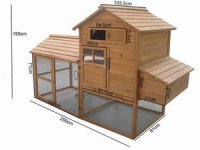Good advice there from Sage Sparrow. I think we have to avoid the feeling that, because we might find conditions cold in a coop overnight,the birds will feel the same as us. I don't think hybrids are poorly feathered, atm mine are better off than my Sussex, who looks like a tatty ex-batt because of moulting, and my legbar is also fine, although legbars are similar to leghorns. It would be a mistake to put chickens straight in the outside world in winter if they'd been used to living indoors, which makes problems for people taking on ex-batts at this time of year, but if birds have been living out all the autumn they become acclimatised to the change in the weather. I do think it helps to have some sort of windbreak round at least part of the sides of the run, I've found white plastic tarp very effective, and also my coop is situated so the open pophole is sheltered from direct blasts of wind overnight. Hens definitely don't like wind and appreciate shelter from it - they often use the perches at the sheltered end to hang out on windy days, or get under the coop, whilst on calm cold days they use the perch out in the open part of the run where they can see what's going on. The sheltered end is also roofed so it stays dry. If they have dry shelter, they can and do choose what's best for them according to conditions outside.

